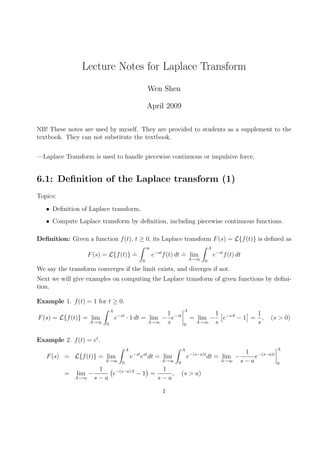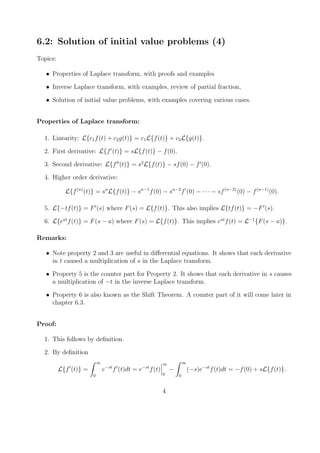- The document provides lecture notes on the Laplace transform, including definitions, properties, examples of computing Laplace transforms, and using Laplace transforms to solve initial value problems.
- The key aspects covered are the definition of the Laplace transform, examples of computing Laplace transforms of various functions, properties of the Laplace transform including how derivatives relate to the transform, and using Laplace transforms to solve initial value problems by taking the transform of both sides, solving for the transformed function Y(s), and then taking the inverse transform.
- Solutions of initial value problems using Laplace transforms generally involve taking the transform of both sides, solving the resulting algebraic equation for Y(s), and then taking the inverse Laplace transform of Y(s) to find the

















![Inverse transform: We use two properties:
L{uc(t)} = e−cs 1
s
, and L{uc(t)f(t − c)} = e−cs
· L{f(t)} .
In the following examples we want to find f(t) = L−1
{F(s)}.
Example 10.
F(s) =
1 − e−2s
s3
=
1
s3
− e−2s 1
s3
.
We know that L−1
{ 1
s3 } = 1
2
t2
, so we have
f(t) = L−1
{F(s)} =
1
2
t2
− u2(t)
1
2
(t − 2)2
=
( 1
2
t2
, 0 ≤ t < 2,
1
2
t2
− 1
2
(t − 2)2
, 2 ≤ t.
.
Example 11. Given
F(s) =
e−3s
s2 + s − 12
= e−3s 1
(s + 4)(s + 3)
= e−3s
µ
A
s + 4
+
B
s − 3
¶
.
By partial fraction, we find A = −1
7
and B = 1
7
. So
f(t) = L−1
{F(s)} = u3(t)
£
Ae−4(t−3)
+ Be3(t−3)
¤
=
1
7
u3(t)
£
−e−4(t−3)
+ e3(t−3)
¤
which can be written as a p/w continuous function
f(t) =
½
0, 0 ≤ t < 3,
−1
7
e−4(t−3)
+ 1
7
e3(t−3)
, 3 ≤ t.
Example 12. Given
F(s) =
se−s
s2 + 4s + 5
= e−s s + 2 − 2
(s + 2)2 + 1
= s−s
·
s + 2 − 2
(s + 2)2 + 1
+
s + 2 − 2
(s + 2)2 + 1
¸
.
So
f(t) = L−1
{F(s)} = u1(t)
£
e−2(t−1)
cos(t − 1) − 2e−2(t−1)
sin(t − 1)
¤
which can be written as a p/w continuous function
f(t) =
½
0, 0 ≤ t < 1,
e−2(t−1)
[cos(t − 1) − 2 sin(t − 1)] , 1 ≤ t.
18](https://image.slidesharecdn.com/noteslaplace-220425210504/85/NotesLaplace-pdf-18-320.jpg)




